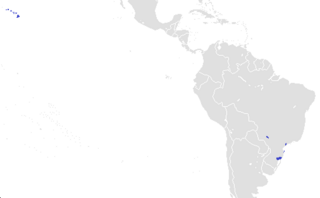
The Bay of Islands is an area on the east coast of the Far North District of the North Island of New Zealand. It is one of the most popular fishing, sailing and tourist destinations in the country, and has been renowned internationally for its big-game fishing since American author Zane Grey publicised it in the 1930s. It is 60 km (37 mi) north-west of the city of Whangarei. Cape Reinga, at the northern tip of the country, is about 210 km (130 mi) by road further to the north-west.

A planarian is one of many flatworms of the traditional class Turbellaria. It usually describes free-living flatworms of the order Tricladida (triclads), although this common name is also used for a wide number of free-living platyhelminthes. Planaria are common to many parts of the world, living in both saltwater and freshwater ponds and rivers. Some species are terrestrial and are found under logs, in or on the soil, and on plants in humid areas.

The New Zealand flatworm is a large land flatworm native to New Zealand. It can vary from 5 mm in length when hatched to approximately 17 centimetres (6.7 in) in mature adults.

Geoplanidae is a family of flatworms known commonly as land planarians or land flatworms.

Bipalium is a genus of large predatory land planarians. They are often loosely called "hammerhead worms" or "broadhead planarians" because of the distinctive shape of their head region. Land planarians are unique in that they possess a "creeping sole", a highly ciliated region on the ventral epidermis that helps them to creep over the substrate. Several species are considered as invasive to the United States and to Europe. Some studies have begun the investigation of the evolutionary ecology of these invasive planarians.

Caenoplana coerulea, known as the blue planarian or blue garden flatworm is a species of land planarian.

Dugesiidae is a family of freshwater planarians distributed worldwide. The type genus is Dugesia Girard, 1850.
Cura is a genus of freshwater flatworm (triclad)s belonging to the family Dugesiidae.
Neppia is a genus of dugesiid triclad that is found in South America, Subantarctic region, Africa, Tasmania and New Zealand.

Arthurdendyus is a genus of land planarians from New Zealand.

Endeavouria is a monotypic genus of land planarians from the Pacific region. It contains a single species, Endeavouria septemlineata.
Eudóxia Maria Froehlich was a Brazilian zoologist.

Luteostriata abundans is a species of Brazilian land planarian in the subfamily Geoplaninae. It is a common species in human-disturbed areas in Brazil's southernmost state, Rio Grande do Sul.

Anzoplanini is a tribe of land planarians in the subfamily Rhynchodeminae.

Marionfyfea is a genus of land planarians from Antarctic Islands off New Zealand. However, a species has been described from specimens found in Europe, probably introduced.

Marionfyfea adventor is a species of land planarian described in 2016 from specimens found in the United Kingdom, the Netherlands and France. However, since the species belongs to the genus Marionfyfea, of which the species are known only from subantarctic islands off New Zealand, it is probably an introduced species in Europe.
Anzoplana is a genus of land planarians from Australia, currently comprising a single species, Anzoplana trilineata.
Coleocephalus is a genus of land planarians that currently contains a single species, Coleocephalus fuscus, from Enderby Island, New Zealand.
Eudoxiatopoplana is a genus of land planarians from New Zealand, currently comprising a single species, Eudoxiatopoplana bilaticlavia, that occurs in Stewart Island. It is the sole genus of the subfamily Eudoxiatopoplaninae.
Marion Liddell Fyfe was a New Zealand academic, specialising in taxonomy of planarians and other flatworms, the first woman zoology lecturer at the University of Otago, and the first woman to be elected to the Council of the Royal Society Te Apārangi.










